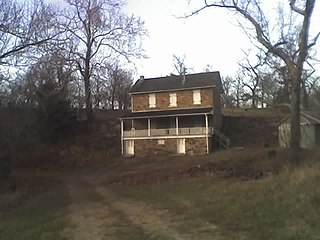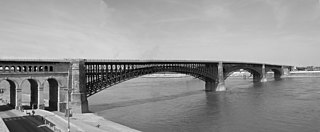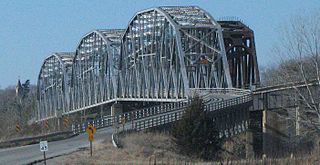
Linn County is a county located in east-central Kansas. As of the 2010 census, the county population was 9,656. Its county seat is Mound City, and its most populous city is Pleasanton. The county was named for Lewis F. Linn, a U.S. Senator from Missouri.

Osawatomie is a city in Miami County, Kansas, United States, 61 miles (98 km) southwest of Kansas City. As of the 2010 census, the city population was 4,447. It derives its name from two streams nearby, the Osage and Potawatomie.
The Battle of Marais des Cygnes took place on October 25, 1864, in Linn County, Kansas during Price's Missouri Raid in the American Civil War. It is also called the Battle of Osage, or the Battle of Trading Post. It proved to be the first of three interconnected actions on this same day, all involving elements of Major General Sterling Price's Confederate Army of Missouri, and the Union's Provisional Cavalry Division commanded by Major General Alfred Pleasonton.

The Marais des Cygnes River is a principal tributary of the Osage River, about 217 miles (349 km) long, in eastern Kansas and western Missouri in the United States. Via the Osage and Missouri rivers, it is part of the watershed of the Mississippi River.

The Little Osage River is an 88-mile-long (142 km) tributary of the Osage River in eastern Kansas and western Missouri in the United States. Via the Osage and Missouri rivers, it is part of the watershed of the Mississippi River.

James Barney Marsh was an engineer and bridge designer born in North Lake, Wisconsin.

The Marais des Cygnes massacre is considered the last significant act of violence in Bleeding Kansas prior to the outbreak of the American Civil War. On May 19, 1858, approximately 30 men led by Charles Hamilton, a Georgian native and proslavery leader, crossed into the Kansas Territory from Missouri. They arrived at Trading Post, Kansas in the morning and then headed back to Missouri. Along the way they captured 11 Free-Staters, none of whom were armed and, it is said, none of whom had participated in the ongoing violence. Most of the men knew Hamilton and apparently did not realize he meant them harm. These prisoners were led into a defile, where Hamilton ordered the men to shoot. He even shot and fired the first bullet himself. Five men were killed and five severely wounded. Only one Free-Stater escaped injury.

The South Omaha Veterans Memorial Bridge was a continuous warren through truss bridge over the Missouri River connecting Omaha, Nebraska with Council Bluffs, Iowa via U.S. Highway 275.
Prairie Spirit Trail State Park is a rail trail that is a Kansas State Park.

The King Iron Bridge & Manufacturing Company was a late-19th-century bridge building company located in Cleveland, Ohio. It was founded by Zenas King (1818–1892) in 1858 and subsequently managed by his sons, James A. King and Harry W. King and then his grandson, Norman C. King, until the mid-1920s. Many of the bridges built by the company were used during America's expansion west in the late 19th century and early 20th century, and some of these bridges are still standing today.

The Keystone Bridge Company, founded in 1865 by Andrew Carnegie, was an American bridge building company. It was one of the 28 companies absorbed into the American Bridge Company in 1900. The company advertised its services for building steel, wrought iron, wooden railway and road bridges. It held a patent for wrought iron bridges and also supplied wrought iron columns for buildings. Thomas Carnegie worked for Keystone Bridge as treasurer for roughly 20 years, from the founding of the company until his death in 1886.

Canton Bridge Company was a firm that was later incorporated into the American Bridge Company. The firm was established in Canton, Ohio in 1892 and became one of the nation's biggest bridge-builders during the early 20th century. It designed and/or built many bridges that later became listed on the U.S. National Register of Historic Places (NRHP).

The Missouri Valley Bridge & Iron Co., also known as Missouri Valley Bridge Company, was a firm that built many bridges. It was based in Leavenworth, Kansas, with a WWII facility in Evansville, Indiana.

The Midland Bridge Company is a firm based in Kansas City, Missouri that has built numerous bridges. Several of its works are listed on the U.S. National Register of Historic Places (NRHP).
Standard Bridge Company was an American bridge company that was "one of the most important bridge building firms in Nebraska history."

George Herndon Pegram, most commonly known as George H. Pegram, was an engineer who patented the Pegram truss.
Papinville is an unincorporated community in Bates County, Missouri, United States.
Walnut Creek is a stream in the U.S. states of Kansas and Missouri. It is a tributary of the Marais des Cygnes River.

Papinville Marais des Cygnes River Bridge, is a historic Pinned Pratt through truss located at Papinville, Bates County, Missouri. It was built in 1884 by the Kansas City Bridge and Iron Co. and spans the Marais des Cygnes River. It is a three span bridge with a central Pratt truss measuring 116 feet and two connected Warren-pony truss spans. It rests on stone abutments with concrete and steel piers and measures a total 234 feet long.

















